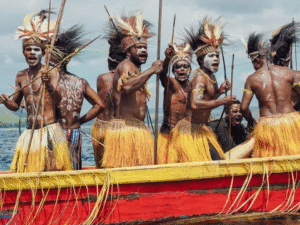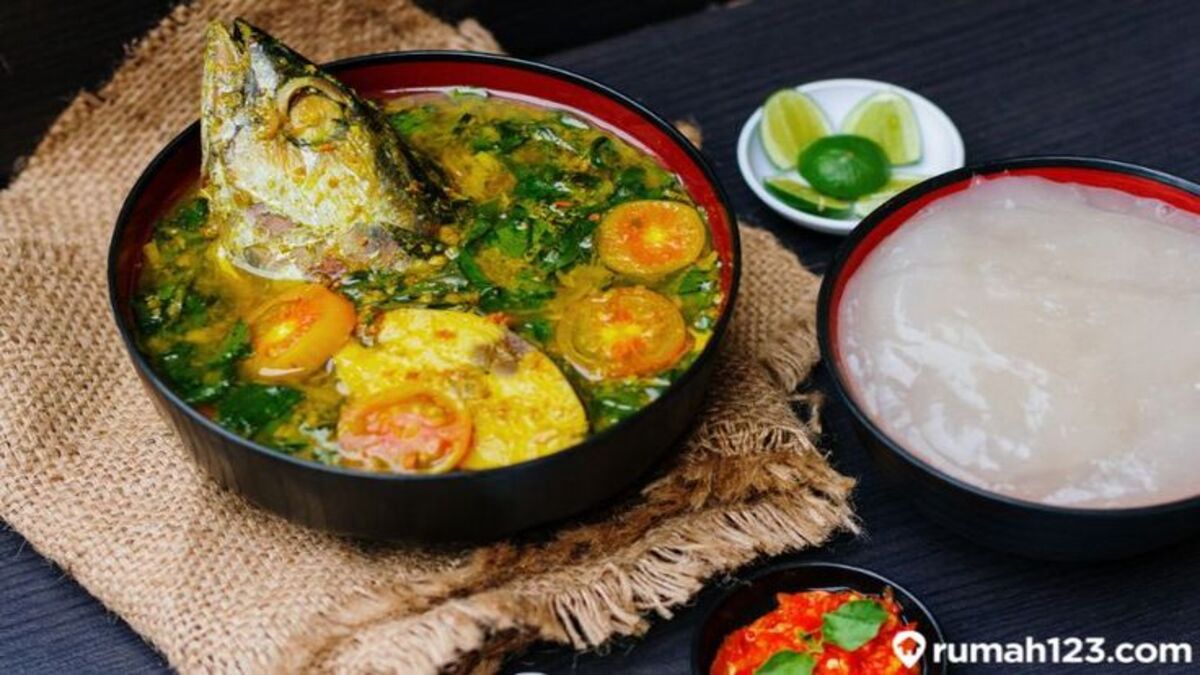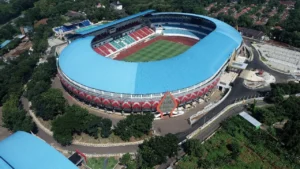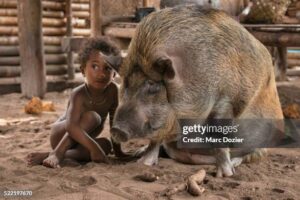Introduction: A Taste of the Land of Papua

Papua, the easternmost region of Indonesia, is not only rich in natural beauty and culture but also in gastronomic treasures that remain deeply rooted in tradition. Among the many culinary gems from this land, two dishes stand out as icons of Papuan identity:
- Papeda Bungkus (Wrapped Papeda)
- Ikan Louhan Goreng (Fried Louhan Fish)
These dishes are more than just food—they are stories, rituals, and experiences passed down through generations. They reflect the Papuan relationship with nature, community, and heritage.
In this article, we’ll take you on a flavorful journey into the heart of Papuan kitchens, forests, and fishing villages—where food is prepared with soul and served with pride.
Chapter 1: Understanding Papuan Culinary Roots
Papuan cuisine is heavily influenced by:
- Geographic environment: forests, rivers, coasts
- Indigenous culture: Melanesian cooking methods and taboos
- Local ingredients: sago, tubers, freshwater fish, banana leaves, spices
In Papua, food is not just about taste—it’s about survival, ceremony, and community.
Traditional meals are often cooked in open fires, wrapped in natural leaves, and shared communally. Ingredients are foraged, hunted, or caught, making them fresh, organic, and local.
Chapter 2: The Sacredness of Papeda
Papeda is perhaps the most iconic food of Eastern Indonesia, especially in Papua and Maluku. It’s a glue-like porridge made from sago starch—a staple carbohydrate in Papuan communities.
What Makes “Wrapped Papeda” Special?
While papeda is typically served plain in bowls, in Papuan villages like Merauke, Sarmi, and Sentani, it is often wrapped in banana leaves for:
- Ceremonial offerings
- Outdoor travel or hunting trips
- Communal feasts in traditional houses (honai)
The wrapped version holds spiritual and practical value. The banana leaves act as:
- Natural preservative and insulator
- Flavor enhancer
- Symbol of respect when offered to guests or elders
Chapter 3: The Art of Making Wrapped Papeda
Ingredients:
- Sago flour (locally harvested)
- Boiled water
- Banana leaves (heated over fire to soften)
- Optional: wild lime or wood ash for flavor
Preparation Steps:
- Mix sago with cold water in a wooden bowl
- Pour boiling water while stirring quickly
- When it thickens into gelatinous texture, spoon it onto banana leaves
- Wrap tightly and tie with bamboo strings or vines
- Optionally, steam or grill it over a fire for a smoky aroma
Wrapped papeda is usually eaten with fish soup, wild vegetables, or spicy sambal colo-colo.
Chapter 4: Louhan Fish – From Aquarium to Kitchen?
Yes, you read that right. The Louhan (Flowerhorn) fish, known globally as an ornamental fish due to its vibrant colors and distinctive forehead, is also consumed in parts of Papua.
This may come as a surprise, but in rural Papuan areas, particularly near floodplains and river deltas, louhan are caught in the wild or bred in freshwater ponds—not the ornamental strains, but edible species with similar morphology.
Chapter 5: Fried Louhan Fish – Local Secret, National Surprise
Why Louhan?
- Thick, meaty flesh
- Mild but distinctive taste
- Abundant in inland fisheries
- Easy to fry whole or fillet
Cooking Fried Louhan in the Papuan Way:
- Clean the fish thoroughly, removing scales and guts
- Marinate with lime juice, garlic, red ginger, turmeric, and salt
- Let it sit for at least 1 hour
- Deep fry until golden and crispy
- Serve with sambal dabu-dabu, stir-fried daun gedi, or wrapped papeda
In highland regions, fried louhan is sometimes smoked or cooked in batu bakar (stone oven) style—placing the fish over hot stones and covering it with banana leaves.
Chapter 6: Cultural Significance of These Dishes
Both wrapped papeda and fried louhan are more than culinary delights—they are symbols of identity.
- Papeda represents the earth, as it comes from the sago tree and is wrapped in leaves
- Louhan fish represents the water, the rivers and lakes that sustain life in Papua
Together, the dishes are often presented during major events like:
- Tribal ceremonies
- Baptisms or weddings
- Visits from village elders or government guests
- Independence Day (17 Agustus) celebrations in kampung
Serving these dishes is a way of honoring both guests and ancestors.
Chapter 7: Voices from the Land
“Papeda bukan sekadar makanan. Ini adalah tanda bahwa kami masih menjaga warisan leluhur kami.”
— Mama Rosina, pengolah sagu tradisional di Sentani
“Louhan di sini bukan untuk akuarium. Kami tangkap dan makan bersama keluarga. Dagingnya lembut dan enak.”
— Markus, nelayan di pinggiran Danau Yamor
“Kalau ada tamu dari luar Papua, kami pasti siapkan papeda bungkus dan louhan goreng. Mereka selalu kaget dan senang.”
— Yuli, pemilik warung makan di Merauke
Chapter 8: Preserving Culinary Heritage in Modern Times
Despite the richness of Papuan cuisine, these dishes are at risk of disappearing due to:
- Urbanization and migration
- Shift to instant and packaged foods
- Environmental degradation of sago forests and rivers
- Loss of traditional cooking skills among youth
Thankfully, efforts are underway to preserve them:
- Culinary festivals featuring regional dishes
- Cooking classes for youth organized by churches and adat groups
- YouTube channels run by Papuan chefs and food vloggers
- Promotion of “eco-culinary tourism” in Papua
Chapter 9: Where Can You Try These Dishes?
If you’re visiting Papua, especially Merauke, Jayapura, or Wamena, look out for:
- Local warungs and rumah makan
- Pasar mama-mama Papua (Papuan mothers’ market)
- Homestay kitchens in tribal villages
- Cultural festivals like FDS (Festival Danau Sentani) or PON Papua
Pro tip: Always ask respectfully before filming or documenting the cooking process. Many of these methods are considered sacred and family-specific.
Chapter 10: Culinary Diplomacy – Sharing Papuan Dishes with the Nation
Wrapped papeda and fried louhan fish have begun to gain national recognition. They’ve been featured in:
- TV shows like “Jejak Si Gundul” and “Makan Besar TransTV”
- Exhibitions by the Ministry of Tourism and Creative Economy
- Culinary blogs and Instagram posts by traveling foodies
Food has become a diplomatic tool—bridging the gap between the center and the periphery, showing that Papua is not only rich in gold and gas, but in soul and flavor.
Conclusion: Celebrating Identity through Food
Papua’s culinary treasures, such as wrapped papeda and fried louhan fish, are not just meals. They are living traditions, connecting generations, communities, and cultures.
By preserving and celebrating these dishes, we preserve Papua’s place in the national narrative—not as a remote province, but as a central pillar of Indonesia’s cultural richness.
Let us savor, support, and share these culinary gems with the respect they deserve.
Read More :
- Inside Papua: Discovering the Unique Tribes of Indonesia’s Eastern Frontier
- Raja Ampat: The Ultimate Underwater Adventure in Southwest Papua
- Echoes of the Jungle: Traditional Musical Instruments of Papua
- In Java People Hijack Rice Fields Using Cows, in Papua Using Pigs
- Grasberg Mine: How Freeport Built the Largest Gold Mine in Papua









